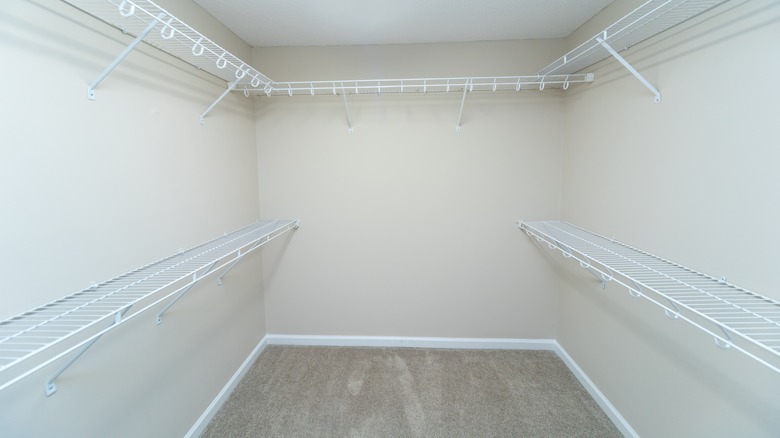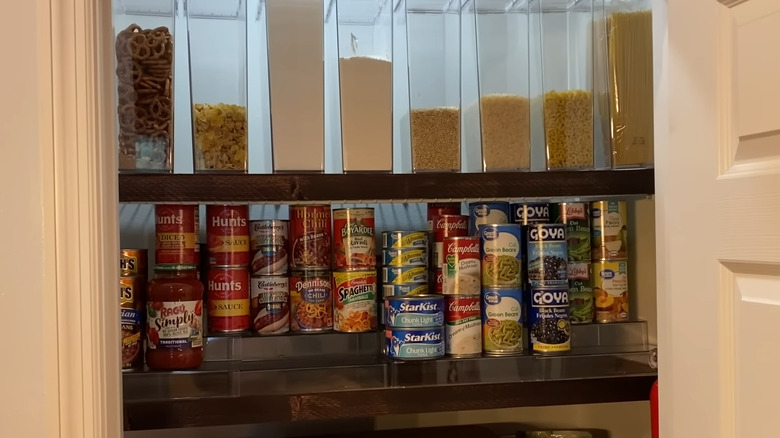Hide Ugly Wire Shelves To Create A Lovely Closet Aesthetic With This DIY
Hiding wire shelves seems to be a big deal. If your YouTube recommendations are like ours, you probably see more ways to conceal this builder-grade decking than try-on hauls and "Fortnite" gameplay combined. The best we've seen, though, is over on Instagram, where Molly Miller (@therenegadehome) builds shelf covers with plywood and solid pine boards to transform an entire closet with a more refined look. And the best part? The entire project costs less than $100. The solid surface also makes it easier to maximize storage with accessories like wire shelf risers from Dollar Tree. This is especially effective in closets and cutouts where there's no door, or where the barrier remains open (perhaps a mud room nook or mini-pantry).
You might be thinking that once you build reasonably sturdy shelves (think plywood and pine, not foam board and shelf paper), you're about an inch from the finish line of having actual wood shelving. All you'd need to complete the conversion is some 2x2-inch cleats (assuming you have convenient studs to screw into) running along the bottom of the shelves on each wall for support. This would eliminate the hanging hardware that's still visible with the shelf covers, and the end result might be slightly stronger. But removable shelf covers are easier to clean, and starting with them doesn't mean you can't add the cleats and remove the wire shelves later. With this in mind, there's no pressing reason to do full wood shelving first.
How Miller's shelves are made
Molly Miller uses cabinet-grade plywood, which gives you the choice of ½-inch and ¾-inch ply. Measure your shelving and do the math to determine how much you need. Now, cover the fronts of the shelves with an unfinished solid pine board (1x3-inch or 1x4-inch boards, depending on the look you're going for and what's available). Beyond that, there's only sandpaper, wood glue, brad nails, stain, and polyurethane sealer. Cut the plywood to the width and depth of your wire shelves and the pine board to the width of the shelving. Apply wood glue to the front edge of the plywood and attach the pine front using a brad nailer to keep everything in place until the glue dries. Sand, stain, seal, and you're done.
Your instinct might be to cut the plywood and board to the full width of the area of your shelves so that there's no gap along the sides. But there are a couple of reasons to give yourself some wiggle room here. For one, certain types of shelving supports — usually made of plastic — will stick up and out in ways that prevent you from simply resting a fitted shelf cover directly on the wire. In this case, you'll need some space so the covers fit between these brackets. Also, in many cases you'll need to insert the shelf covers into the closet or cutout at an angle and then twist and lower them into place, which can be challenging or impossible with cut-to-fit shelves.
Some tips and alternatives
It's perfectly possible to make the shelf covers entirely of plywood with only one additional cut. Simply cut the ply to the shelf depth plus the finish board height, then cut the front piece from that. However, using solid pine for the shelf cover fronts eliminates the need to cover the exposed plywood edges with edge banding or the like to keep your DIY wood projects from looking cheap. If you're painting your shelves, there's not much of an issue here — with a little wood filler and sanding, priming, and paint, the plywood edge will disappear. But it's substantially more work for only a few bucks in savings.
Sometimes these shelf covers are made from paneling rather than plywood. If you try this, you'd definitely want to stain the exposed edge of the paneling or, better yet, rabbet the pine front to hide the edge of the paneling. One minor issue with any solution that requires the front trim piece to ride under the shelf part of your cover is that you can't adjust the design by moving the trim board up, creating a lip to keep things like spice jars from constantly falling off. Another interesting material combination is laminate shelving and PVC molding, and we've even seen shelf covers made entirely from foam board from Dollar Tree, or foam board and contact paper, and endless other DIY liners you can use in your shelves, cabinets, and drawers.

